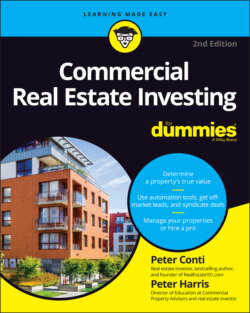Читать книгу Commercial Real Estate Investing For Dummies - Peter Harris - Страница 23
Risk-proofing your investment plan
ОглавлениеIn our years of investing and watching numerous successful and not-so-successful investors go at it, we have come up with several fail-safe measures (we call them common-sense measures!) for risk-proofing your investing. Here they are:
Do proper due diligence. Due diligence is the process you go through when verifying the financial documents of the property, performing a physical inspection, and checking out the legal pieces of the property, such as the title. Ninety percent of all deals die during due diligence. So, if you don’t do a thorough job, the consequences can be costly. You may end up buying a property that’s a money pit. However, when done properly, due diligence can actually help you make your sweet deal even sweeter. Reading Chapter 7, which provides the ins and outs of due diligence, may save you millions of dollars.
Don’t overpay. Overpaying is common among new investors. Don’t be the investor in a deal where the agent sets a record price on selling a property! If you’re buying apartments, make sure that you’re aware of what price you’re paying per unit. If you’re buying a shopping center, make sure you know how much you’re paying per square foot. In both cases, see what the recent market closings value your property at. Paying too much will lock up the property’s cash flow for a long time. (See Chapter 3 for more on pricing your prospective properties.)
Have expert market knowledge. Knowing your market like the back of your hand sets you up for success. Before you close on your deal, make sure you know the following:How competitive your rents are with other similar local propertiesWhen and if there’s a “slow season” for rentals so you can plan aheadWhether there’s rent control in your city, which would inhibit you from raising rents as you thought you couldWe also like to inquire on crime statistics on the property in question by calling the local police department.
Hold your goals loosely. What we mean is that you should keep your investment’s exit strategy flexible at all times. An exit strategy has two parts, a plan to modify or improve the property and a method to sell or trade into another property. We like to have several exit strategies ready at any given time. Market conditions change. Your personal circumstances can change rapidly as well. So, don’t get wrapped up in executing just one exit strategy, because it may no longer apply.
Know where you are in the real estate cycle. There are four parts to any real estate cycle: expansion, contraction, recession, and recovery. By reading Chapter 2, you can figure out where your particular city is in the cycle, and you can determine when to buy, sell, hold, or bail. Each part of the cycle demands that you pay detailed attention to your investment decisions. Understanding real estate cycles helps you take the correct actions with the best timing. There’s nothing like timing the market like a pro!
You'll discover that controlling the risk in your commercial investments begins with finding good deals (Chapter 5) and managing them well (Chapter 12). Unfortunately, there's not one box that you can check off to eliminate risk. What you can do is learn to make good decisions so that you're acquiring stable properties which are much less likely to fail. (See Chapter 14.) You may have thought that risk-proofing was impossible, but you’d be surprised at what a little knowledge can do to your investment portfolio.
